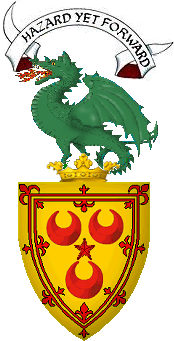 |
A History of the Seton's
of Parbroath
Lindores Abbey and its burgh of Newburgh:
Their History and Annals
By Alexander Laing
 Sir Alexander Seton of Seton came
of a race that fought bravely and suffered much for the independence of
Scotland. He signed the famous letter to the Pope, and his whole career shows
how faithfully he fulfilled the vow he had made. Alexander, supposed to be his
eldest son, was killed in opposing the landing of Edward Baliol near Kinghorn
(6th August 1332). Sir Alexander Seton of Seton came
of a race that fought bravely and suffered much for the independence of
Scotland. He signed the famous letter to the Pope, and his whole career shows
how faithfully he fulfilled the vow he had made. Alexander, supposed to be his
eldest son, was killed in opposing the landing of Edward Baliol near Kinghorn
(6th August 1332).
His second son Thomas, a comely
and noble looking youth, a hostage in the lands of Edward III, for the surrender
of Berwick if not relieved, was hanged before the gate of that town, so near
that his father the governor, could witness his son's execution ; but with
unswerving patriotism Sir Alexander refused to save his son by the betrayal of
his trust; and he saw his third son William drowned in a gallant attack on the
English fleet, near Berwick. The fate of Seton's sons brings painfully
before us the heroic sacrifices by which the independence of the country was
maintained.
Parbroithe. Anciently the property of the Ramsays, it passed by marriage, in the
beginning of the 14th century, to a branch of the family of Seton. 'The first
proprietor of Parbroath of the name of Seton was John, fourth son of the famous
Alexander Seton, Governor of Berwick. He became proprietor of the lands of
Parbroath by marrying Elizabeth Ramsay, heiress thereof.' New Statistical
Account, Parish of Creich.
The history of this alliance, and
of the Setons of Parbroath, is thus quaintly related by Sir Richard Maitland in
his ' Historie of the House of Seytoun':
'King David II. gave to the said
Sr Alexander the heretrix of Parbroth, callet Elizabeth Ramsay, dochter and air
of Sr Niel Ramsay, knycht; quhilk Elizabeth the said Sr Alexander gave in
maryage to his sone callet Johne, as I sall efter schaw. This Sr Alexander deit
in the latter [days] of the foresaid King David and was of grit age.' Alexander
Seton of Parbroth was one of the counsellors of Lord Glamys in the dispute
between the convent of Lindores and the burgesses of Newburgh in 1493-4 (see pp.
178-182). 'The fourt sone of Alexander Seytoun quha kepit Berwik, callet Johne,
mareit the foresaid Elizabeth Ramsay, heretrix of Parbroth, quha bair to him ano
sone callet Alexander; quhilk Alexander begat Sr Gilbert, knycht. This Sr
Gilbert mareit Marioun Petcarue upon quhom he got fyve sonnis. The eldest callit
Sr Alexander, knycht, quha succedit till his father; the second sone callit
Williame, quha had also ane sone callit William that mareit Kathariue Butlair,
heretrix of Rumgavye; the thrid sone of the said Sr Gilbert, callet Johne,
mareit Jonet Lauthrysk, heretrix of that Ilk. Of the quhilk Johne are descendit
the Seytounis of Lauthrysk and Baubirny; the fourt sone calleit Maister David
quha wes aue singular honest man and mareit all his elder brotheris dochteris,
efter his deceiss, on landit men and payit thair tocheris, and coft ladyis of
heritage to his brotheris sonnis.'
The old chronicler relates the following graphic incident in the life of Master
David:—; In the tyme of King James the Ferd there was ane process laid aganis
the baronuis, callit recognitionis. The Advocate at that tyme wes named Maistcr
Richard Lausone and his assistant Maister James Henrysone. Maister David Seytoun
in his defence of Lord Seytounis case said to the king, 'Schir, quhen our
forbears gat yon landis at your maist uobill prcdecessouris [handis] for their
trew service; sumtyme gevand the blude of thair bodie, and sum tyme their lives
in defence of this realme; at that tyme there wes nother Lau sone, nor Henry
sone quha wald invent wayis to disheris the baronnis of Scotland.' The king
seeing the warmth with which he made his defence said to him, 'Would you fight?'
The old cleric, who was beyond the age when he had a right to challenge a
decision by single combat, said that if the king would give permission he would
fight his opponent. 'The kingis grace quha wes the maist nobil and humane prince
in the warld smylit and leuch a little, and said na mair;' admiring in his heart
the nobility of the man who stood up so bravely for the rights of his kindred.
'This Maister David wes persoun of Fettercarne and Balhelvy; and ane large man
of bodic as was in his dayis, and stout thairwyth, the best lyk ageit man I ever
saw. He levit quhill he was lxxx yeiris, undecrepit and did mony other actis
wordy to be put in remembrance quhilk I omit for shortness. The fift sone callit
Gilbert, ane Maister clerk, deit at Rome.'
The said Sir Alexander, eldest sone to Sir Gilbert [and Marioun Petcarne]
mareit [circa 1640] Helen Murray dochter to the lard of Tulybardiu, and gat on
her one sone callit Alexander, quho deit befoir his father. This Alexander
mareit Katherine, dochter to the Lord Lyndsay of the Byris, and gat upon hir tua
sounis, the eldest callit Johne quha succedit to his gudschir, and was slaue at
Floudane, levand behind him na successouris of his body. Ane vther callit Andro
quha succedit to the said Johne, his brother and levis presentlie. This Andro
mareit Balfour, dochter to the lard of Burlie, and gat upon hir ane sone callit
Gilbert quha was slane at the field of Pinkye, his father yet leiffand.
This Gilbert mareit Margaret
Leslie, dochter to the Erle of Rothos, on quhom he gat David appeirand heir to
his gudschir Audro. The rest of the successioun of the hous of Parbroth and the
granis collateral of the samin, with their successioun and actis done by them, I
refer to them that are descendit of the samin hous.'—Maitlancts Historie of the
House of Seytoun.
Sir Richard Maitland's account of the House of Parbroath only comes down to the
year 1560, and none of 'the hous, or the granis collateral,' having left any
account of the family behind them, we are left to glean their subsequent history
from scattered scources.
David Seton was served heir to
his grandfather in 1563.—Fife Eetours 51. David Seton of Parbroath, who became
Comptroller of Scotland, married Mary, daughter of Patrick sixth Lord Gray,
circa 1590. In the next century, Margaret Seaton of the family of Parbroath,
married Sir John Scrimgeour of Dudhope, who was created, Viscount Dudhope and
Lord Scrimgeour by Charles I. in 1641. He was appointed by the same monarch
Heritable Standard Bearer of Scotland, an honour which is held by the descendant
of this marriage, Henry Scrimgeour Wedderburn of Birkhill. Peerage of Scotland,
Wood's Ed., Vol. I., pp. 466, 671.
Parbroath passed out of the hands
of the Setons towards the end of the 17th century. The latest notice we have of
the family is in Burke's 'Landed Gentry' (1850), where it is stated that 'Sir
Walter Synnot of Ballymoyer, in the county of Armagh, Ireland, married in 1770
Jane, daughter of John Seton of Camberwell, Surrey, representative of the Setons
of Parbroath.' In the year 1694, at which date the oldest volumes of the
Parochial Registers of the parish of Creich begins, Parbroath formed part of the
estate of Mr Andrew Baylie of the family of Carfin, in the west of Scotland.
The house of Parbroath was a ruin
at the beginning of the 18th century, when Sir Robert Sibbald published his
History of Fife, and all that remains of the residue of a race who 'gave the
blude of their bodie and their lives in defence of this-realme,' is the half of
an arch standing in the middle of a ploughed field. Parbroath (usually
pronounced Petbroad) is now the property of Captain H. W. Hope.—On Ainslie's Map
of Fife, published in 1774, the name is given, Pitbroad
|

